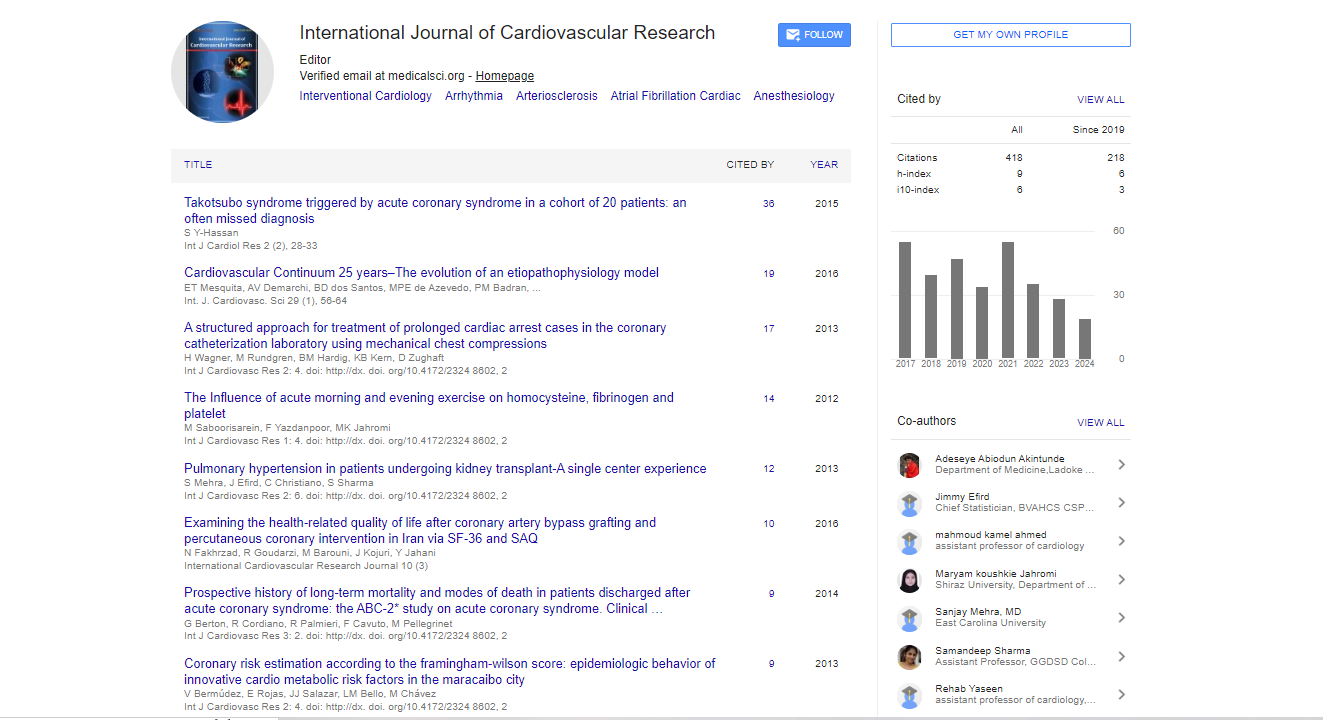Commentary, Int J Cardiol Res Vol: 13 Issue: 4
Advances and Challenges in Pediatric Cardiology and Congenital Heart Disease
David Roberts*
1Department of Cardiovascular Medicine, University of Oxford, Oxford, United Kingdom
*Corresponding Author: David Roberts,
Department of Cardiovascular Medicine,
University of Oxford, Oxford, United Kingdom
E-mail: david.roberts@cardiov.ox.ac.uk
Received date: 15 July, 2024 Manuscript No. ICRJ-24-149306;
Editor assigned date: 17 July, 2024, PreQC No. ICRJ-24-149306 (PQ);
Reviewed date: 31 July, 2024, QC No. ICRJ-24-149306;
Revised date: 07 August, 2024, Manuscript No. ICRJ-24-149306 (R);
Published date: 14 August, 2024, DOI: 10.4172/2324-8602.1000579
Citation: Roberts D (2024) Advances and Challenges in Pediatric Cardiology and Congenital Heart Disease. Int J Cardiol Res 13:4.
Description
Congenital Heart Disease (CHD) represents one of the most common birth defects, affecting nearly 1% of all live births worldwide. These structural abnormalities in the heart or great vessels manifest at birth and can vary widely in severity, from simple defects requiring minimal intervention to complex malformations that necessitate lifelong medical management and surgical correction. Pediatric cardiology has made significant strides in diagnosing and treating CHD, leading to improved survival rates and quality of life for affected children. Congenital heart disease refers to a spectrum of structural defects in the heart or major vessels that develop during fetal life. These abnormalities disrupt normal blood flow, leading to oxygenation issues and other circulatory problems. CHD is classified into two broad categories: Cyanotic and acyanotic heart defects. Cyanotic defects causes reduced oxygen levels in the blood, often resulting in a bluish tint to the skin (cyanosis). In contrast, acyanotic defects do not typically cause cyanosis but may result in heart failure or other complications due to abnormal blood flow. CHD ranges from simple defects, such as Atrial Septal Defects (ASDs) or Patent Ductus Arteriosus (PDA), to complex malformations like Tetralogy of Fallot (TOF) or Transposition of the Great Arteries (TGA). With advances in medical care, most children with CHD can now expect to live well into adulthood. However, CHD remains a major cause of childhood morbidity and mortality and ongoing study is essential to improve outcomes.
The exact causes of CHD are often multifactorial, involving a combination of genetic and environmental factors. Genetic mutations or chromosomal abnormalities are identified in some cases. For example, Down syndrome (trisomy 21) is strongly associated with atrioventricular septal defects, while DiGeorge syndrome (22q11.2 deletion) is linked to conotruncal defects, such as TOF. Environmental factors, including maternal health and exposure to teratogens during pregnancy, also play a significant role in the development of CHD. Maternal diabetes, obesity and certain infections, such as rubella, increase the risk of congenital heart defects. Exposure to alcohol, smoking and certain medications during pregnancy can further heighten the risk. While many cases of CHD are sporadic, advances in genetic study have identified specific mutations linked to congenital heart malformations. Further exploration of genetic predispositions may lead to improved prenatal screening and early detection of at risk pregnancies.
Early diagnosis of CHD is important for optimizing outcomes, as timely intervention can prevent or reduce severe complications. Diagnostic techniques for congenital heart disease have advanced significantly, allowing for early detection and treatment, often during the fetal period. Fetal echocardiography is the primary tool for diagnosing CHD before birth. This non-invasive ultrasound-based imaging technique provides detailed images of the fetal heart, allowing for the identification of structural abnormalities as early as 18-20 weeks gestation. After birth, echocardiography remains the cornerstone of CHD diagnosis. Transthoracic Echocardiography (TTE) allows for real time visualization of the heart's structure and function, enabling precise identification of defects. While echocardiography provides structural information, Electrocardiogram (ECG) assesses the heart's electrical activity, which may be abnormal in certain forms of CHD. These advanced imaging techniques such as cardiac Magnetic Resonance Imaging (MRI) and CT.
The management of congenital heart disease depends on the type and severity of the defect, with treatment options ranging from medical management and catheter-based interventions to open-heart surgery. Advances in pediatric cardiology and cardiac surgery have dramatically improved outcomes for children with CHD. For less severe CHD, medical management may be sufficient. Medications such as diuretics, ACE inhibitors and beta-blockers can help manage heart failure symptoms, control blood pressure and reduce fluid accumulation in patients with acyanotic heart defects. In cases of cyanotic CHD, prostaglandins may be administered to keep the ductus arteriosus open temporarily, ensuring adequate oxygenation until surgical correction. Catheter-based techniques have become increasingly popular due to their minimally invasive nature. Procedures like balloon valvuloplasty or atrial septostomy can be performed to relieve obstructions or create shunts without the need for open-heart surgery. Additionally, device closures of ASDs, VSDs, or PDAs are now commonly performed via catheterization, reducing recovery times and hospital stays. For more complex congenital heart defects, surgical intervention is often necessary. Open-heart surgery may involve repairing or reconstructing the abnormal structures of the heart.
Conclusion
Congenital heart disease represents a significant challenge in pediatric cardiology, but advancements in diagnostic techniques, medical management and surgical interventions have led to remarkable improvements in patient outcomes. Early diagnosis, prompt intervention and continued study into novel therapies will be essential for further reducing the morbidity and mortality associated with CHD. As survival rates improve, the focus is now shifting towards optimizing long-term outcomes and addressing the needs of adults living with congenital heart defects. The future of pediatric cardiology holds great promise, but ongoing efforts are needed to ensure that all children with CHD receive the care they need, regardless of their geographical or socioeconomic background.
 Spanish
Spanish  Chinese
Chinese  Russian
Russian  German
German  French
French  Japanese
Japanese  Portuguese
Portuguese  Hindi
Hindi 



